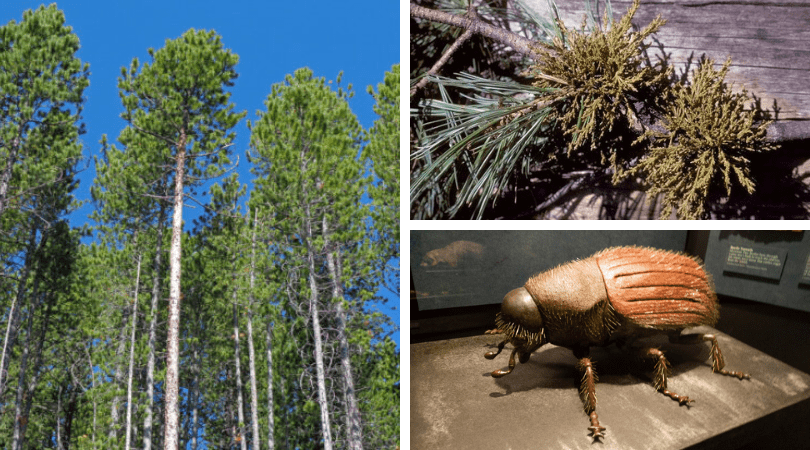Lodgepole pines grow abundantly throughout North America. Known for its straight, slender, and tall trunks, the lodgepole pine is commonly used to build lodges and cabins. Lodgepole pines are unique because they need fire to reproduce. They have serotinous cones or cones that are covered in a thick waxy layer that can only be opened for seed dispersal under extensive heat. Because of this, lodgepole pines are one of the first species to recolonize burned areas.
In the past, frequent wildfires weeded out the sick lodgepole pines and gave room for new saplings to grow. But with the suppression of wildfire throughout the last century and a half, lodgepole pine stands have begun to grow very dense allowing for disease and pests to easily make their way from tree stand to tree stand. The mountain pine beetle, a native beetle to lodgepole pine stands, has been detrimental to lodgepole pine populations wiping out healthy mature trees at the landscape scale.
The lodgepole pines left behind are typically suppressed with low vigor, thin phloem, or diseased with dwarf mistletoe. Dwarf mistletoe is a hemiparasite that steals the majority of the resources the host tree needs to survive, causing high susceptibility to mortality. Dwarf mistletoe causes its infected host to grow dense branch masses, referred to as “witches’ brooms”, around the infected branches. This causes crown deformities resulting in smaller crown sizes and tree height, allowing for an increase in stand density.
With the mountain pine beetle and dwarf mistletoe working together throughout lodgepole tree stands, researchers have noticed a drastic change in stand structure and ecosystem properties in lodgepole pine forests. Dwarf mistletoe decreases the vigor of trees making the trees less desirable to mountain pine beetles, increasing resistance to mountain pine beetle disturbances in stands already impacted by dwarf mistletoe. Researchers have also noticed a trend in dwarf mistletoe outbreaks intensifying in stands post-mountain pine beetle outbreak. Further research will need to be conducted to determine if mountain pine beetles increase or decrease dwarf mistletoe infection in lodgepole pine forest stands.
Full Article: Effects of Dwarf Mistletoe on Stand Structure of Lodgepole Pine Forests 21-28 Years Post-Mountain Pine Beetle Epidemic



Recent Comments